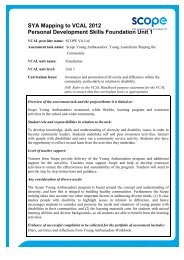Positive behaviour support Getting it right from the start
Positive behaviour support Getting it right from the start
Positive behaviour support Getting it right from the start
You also want an ePaper? Increase the reach of your titles
YUMPU automatically turns print PDFs into web optimized ePapers that Google loves.
<strong>Pos<strong>it</strong>ive</strong> <strong>behaviour</strong> <strong>support</strong>: <strong>Getting</strong> <strong>it</strong> <strong>right</strong> <strong>from</strong> <strong>the</strong> <strong>start</strong> - Facil<strong>it</strong>ators reference manual 9<br />
PowerPoint 13<br />
PowerPoint 14<br />
PowerPoint 15<br />
*<br />
*<br />
*<br />
Where does pos<strong>it</strong>ive <strong>behaviour</strong> <strong>support</strong> come <strong>from</strong>?<br />
The origins of pos<strong>it</strong>ive <strong>behaviour</strong> <strong>support</strong> can be found in <strong>the</strong> movement towards inclusion,<br />
applied <strong>behaviour</strong>al analysis and person-centred values which have as a primary goal enhancing<br />
<strong>the</strong> qual<strong>it</strong>y of life of a person w<strong>it</strong>h a disabil<strong>it</strong>y.<br />
<strong>Pos<strong>it</strong>ive</strong> <strong>behaviour</strong> <strong>support</strong> is a multi-element approach which provides a clear values base, a<br />
defined process and a sense of how to work w<strong>it</strong>h a person who displays <strong>behaviour</strong>/s of concern.<br />
It promotes:<br />
• a comprehensive lifestyle change<br />
• a lifespan perspective<br />
• environmental changes<br />
• stakeholder participation<br />
• social valid<strong>it</strong>y<br />
• multi-component intervention<br />
• emphasis on prevention.<br />
For pos<strong>it</strong>ive <strong>behaviour</strong> <strong>support</strong> to be successful <strong>it</strong> requires:<br />
• team work<br />
• seeing <strong>the</strong> person’s strengths and being comm<strong>it</strong>ted to <strong>the</strong> person<br />
• seeing <strong>the</strong> person and seeing <strong>the</strong> <strong>behaviour</strong><br />
• an appreciation that all <strong>behaviour</strong>s have a purpose<br />
• being pos<strong>it</strong>ive.<br />
<strong>Pos<strong>it</strong>ive</strong> <strong>behaviour</strong> <strong>support</strong>: Assumptions and possible outcomes<br />
<strong>Pos<strong>it</strong>ive</strong> <strong>behaviour</strong> <strong>support</strong> is based on <strong>the</strong> assumption that people w<strong>it</strong>h a disabil<strong>it</strong>y require<br />
different levels of <strong>support</strong> as <strong>the</strong>y learn to self-regulate <strong>the</strong>ir feelings and <strong>behaviour</strong> as by nature<br />
<strong>the</strong>y are likely to feel more anxious or stressed than o<strong>the</strong>rs.<br />
People w<strong>it</strong>h a disabil<strong>it</strong>y can rely on <strong>support</strong> professionals to acknowledge <strong>the</strong>ir feelings and <strong>the</strong><br />
message communicated via <strong>the</strong>ir <strong>behaviour</strong>. Support professionals will provide <strong>the</strong> personal<br />
<strong>support</strong> and affirmation required and gives specific acknowledgement for <strong>behaviour</strong>al learnings.<br />
Support professionals <strong>support</strong> <strong>the</strong> person w<strong>it</strong>h a disabil<strong>it</strong>y to understand what to do and provide<br />
feedback on what has been done well and leads <strong>the</strong> person w<strong>it</strong>h a disabil<strong>it</strong>y towards more<br />
appropriate ways of interacting

















